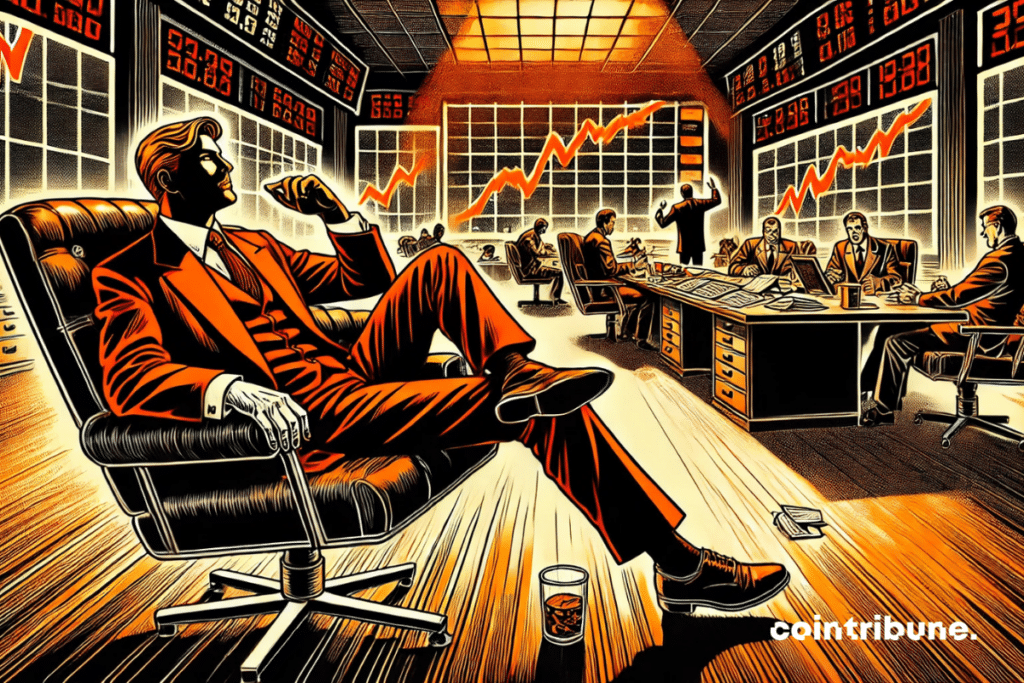Trump Remains Optimistic Despite Market Panic
Donald Trump once again leaves his mark on his time at the head of the United States. By launching a massive tariff offensive against nearly all of the country’s trading partners, the president provokes an economic and diplomatic earthquake. Wall Street is falling, allies are worried, and Beijing is retaliating. This decision, as strategic as it is ideological, marks the assured return of hard protectionism and places American economic sovereignty at the center of the global game.

Shock Tariffs and Freefalling Markets: Trump’s Method in Action
On April 3, 2025, Donald Trump triggered an earthquake on the financial markets with the announcement of a series of customs tariffs imposed on nearly all of the United States’ trading partners.
As he was leaving the White House to attend an event in Miami, he briefly responded to the press:
It was an operation. I like when a patient is operated on and it’s something important. I said it would happen exactly like this.
Donald Trump
This seemingly confident statement comes as the stock market indices plunged into the red, in direct reaction to the announcement.
In the hours that followed, the economic effects of this decision were immediate and massive:
- The Dow Jones fell by 3.75%, marking one of its worst sessions in months.
- The Nasdaq lost 5.75%, illustrating the high sensitivity of the technology sector.
- The S&P 500 dropped by 4.4%, swept away by a wave of widespread selling.
- China reacted firmly. It denounced “unilateral tariff measures” and demanded their immediate withdrawal.
- The White House, through the voice of Karoline Leavitt, insisted on the non-negotiable nature of the measure and described the situation as a “national emergency”.
- The Secretary of Commerce, Howard Lutnick, ruled out any backtracking: “I don’t think Trump is going to back down. These tariffs give immense negotiating power.”
The U.S. authorities justify this tariff offensive as a response to decades of trade imbalances and denounce partners who “had 70 years to act properly and failed,” according to Leavitt. While markets reacted violently, the White House claims to fully assume the initial shock as a necessary step towards a fundamental economic transformation.
An Assured Vision: Trump Defends a Radical Change of Economic Course
From Air Force One, Donald Trump continued to defend this strategy. He asserts that the customs tariffs offered the United States “immense negotiating power.” Moreover, he insisted that these measures were not intended to create a trade blockade, but to force his partners to “make favorable arrangements.”
“They have exploited us for years. Now the rest of the world wants to know if it can make a deal. Well, that depends. If we are offered something phenomenal, then yes,” he stated aboard the presidential aircraft.
Within the executive branch, Vice President JD Vance acknowledged that this policy would bring about “a great change,” but emphasized that Trump “is keeping his promise.” During an interview on Fox & Friends, he acknowledged a “short-term pain,” but justified it by a long-term vision: bringing factories back to the United States.
Trump even specified the timeline: “let’s say it’s a two-year process. These are large factories, often with integrated power facilities. It takes time, but it will be huge.”
Behind the announcements, this tariff policy raises a series of crucial questions for the economic future of the United States and its partners.
The direct cost for American consumers, the risks of trade retaliation, the stability of the stock markets, and the impact on technology and manufacturing industries are all factors that remain unclear at this stage.
Thus, Trump’s approach is based on a strong conviction: industrial recovery will compensate for short-term losses. However, in a globalized world, this transition could be more chaotic than expected.
At a time when economic tensions are becoming as strategic as military ones, this policy could redefine global balances, with repercussions well beyond trade. The crypto sphere, in search of alternative refuges, may find itself once again in the crosshairs of investors looking to protect themselves against systemic instability. It remains to be seen whether the promises of industrial recovery will be enough to compensate for the immediate fractures of such a radical strategy.
Maximize your Cointribune experience with our "Read to Earn" program! For every article you read, earn points and access exclusive rewards. Sign up now and start earning benefits.
Diplômé de Sciences Po Toulouse et titulaire d'une certification consultant blockchain délivrée par Alyra, j'ai rejoint l'aventure Cointribune en 2019. Convaincu du potentiel de la blockchain pour transformer de nombreux secteurs de l'économie, j'ai pris l'engagement de sensibiliser et d'informer le grand public sur cet écosystème en constante évolution. Mon objectif est de permettre à chacun de mieux comprendre la blockchain et de saisir les opportunités qu'elle offre. Je m'efforce chaque jour de fournir une analyse objective de l'actualité, de décrypter les tendances du marché, de relayer les dernières innovations technologiques et de mettre en perspective les enjeux économiques et sociétaux de cette révolution en marche.
The views, thoughts, and opinions expressed in this article belong solely to the author, and should not be taken as investment advice. Do your own research before taking any investment decisions.